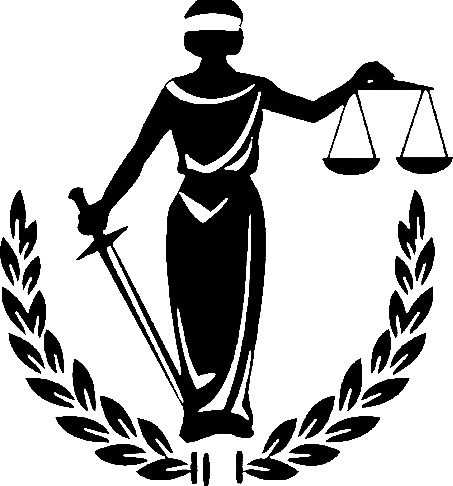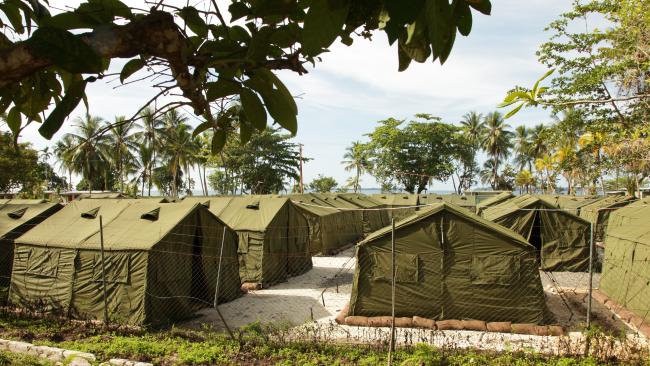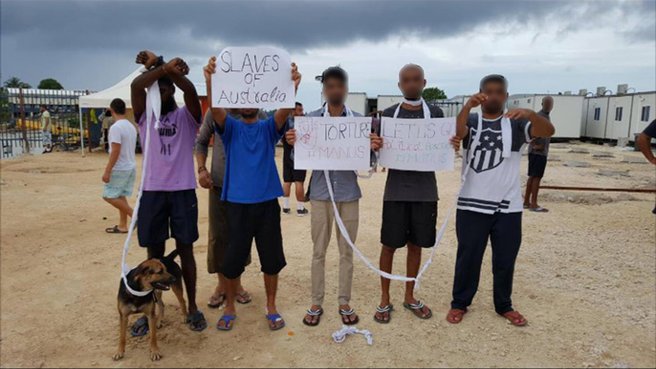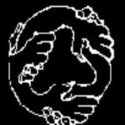- Home
- All the way with Adam
- Analysing Trump-Turnbull Phone X-change
- Are we there yet ?
- Australia's diminishing political capital
- Boat turnback bribery and predictable silence
- Causes for Refugee Movements: Political Interference
- Corrupt Syndicate and Cover-ups
- Crimes of Secretary of DIBP (2011-2014)
- Details on Fazel Chgeni case:
- Election Season and Boat Secrecies
- Elephants and Lies -- Xmas season 2017
- End Offshore Slavery
- Evacuate the Asylum-seekers from Offshore Detention Centres
- Future for PNG Asylum-seekers
- Growing List of Hero Doctors
- Honesty is the best policy on payments to smugglers
- Lady Justice shines on the Pacific
- Lectures and Pressures
- Lets shine our solidarity on Manus Island and Nauru
- Lies, Spins, Cockroach and Rodents
- Ltr to Andrew Wilkie and Adam Brandt MP
- Media monopoly and conspiracy of silence
- Media monopoly: blackout vs spotlight
- Nauruan MOU and Dabwido -- Devil not in Him
- No Lecture, More Pressure
- OSB and Public Interest Immunity
- OSB, Turnbacks and Political cover-ups
- On wherever of the Internet
- Pacific Solution for Justice
- Refugees, Trust and Faith
- Royal Commission on Offshore Processing Regime, an initiative worth supporting
- Serving the Horizontal Outreach
- Shedding some light on OSB
- Should Dutton be sacked for adopting Cockroach Agenda
- Standing up for Refugees ? Set up a FB Group and Becomes Human Rights Information Retailer:
- The 2018 Unpacking of Xmas Lies
- The Syndicate of Corruption
- The myths, secrecies and refugee policy
- The scandal at hand
- Trade Your Vote for Refugees
- Treasonous minions
- UN Refugee Convention and Huston Report 2012 , a case of public mood-swings and government policy shift
- Virtual Communities - All about Respect
- Who gonna park on that spot ?
- Witchcraft behind the Spin
- Put yourself in Indonesian's shoes
- Australian Government's bribery payments to people smugglers
- Boat bribery payments and motives behind
- Labor, Liberal and Mandatory Detention Policy
- The Irony of Australian Government's "Tough on Crimes"
- Tilting at Canberra Windmills
- Why my polly is so silent
- The ALP Position on asylum-seekers detained offshore
- The Cowards of Australia
- Refugee Policy Moonwalks and ALP
- A Lie is a 'Lie' and a Crime is a 'Crime'
- Attributions
- AFP and ICC
- (2022-Sep) OTP-ICC Preliminary finding and Request for ICC jurisdiction
- (2018-Apr) Additional Submission to ICC re: Enslavement
- (2017-Jun) Enslavement in Manus Island and Nauru
- Dob-in to International Criminal Court
- Request ICRC to Evacuate Asylum-seekers
- Rome Statute Article 25 on Individual Responsiblity
- STATE OF TORTURE LAW IN AUSTRALIA
- Urgency on Offshore Situation
- Bomana
- Asylum Processing Under PNG/Naurual Laws: Lawful or Unlawful?
- Freedom Yours, Justice Ours
- LEGAL REMEDY FOR DETAINEES IN KP, MANTRA & ITAs
- ERRONEOUS OFFSHORE LAWS
- LIBERTY - BROADENING THE SCOPE
- EXECUTIVE EMERGENCY POWER, COMMON LAW AND ALIENS
- Bomana53# and Convention Obligation
- Legal Boundary of Offshore Processing Regime
- HCA Failed Offshore Detention Challenge S195/2016
- UNORG
- (Feb 2022) Submission to Human Rights Council and Special Rapporteur on Slavery
- (Sep-2019) Letter to UN Secretary-General Guterres
- (Sep-2018) Letter to President of Nauru and Prime Minister of New Zealand
- (Aug-2019) Resettlement Appeal to European Council
- (Jul-2019) Letter to Canadian PM Justin Trudeau
- (Dec-2017) Letter to President of ICRC
- Slavery
- Deaths in Detention
- Archived: 1992-2004
Submission to Human Rights Council and Special Rapporteur on Slavery
In sum, every known indicators are consistently indicating that Australia's offshore asylum-processing scheme has been a large scale enslavement. The Commonwealth Government of Australia, together with detention companies, therefore have perpetrated crime against humanity of enslavement.
Submission to Human Rights Council / SR Slavery
[Broadcast On: 27/2/2022]
DETENTION SLAVERY -- SUBMISSION TO UN SPECIAL RAPPORTEUR:
I thank Special Rapporteur Mr. Tomoya Obokata for organizing his thematic report focusing on the protection of minorities from contemporary forms of slavery. I am an independent citizen activist in Australia and I appreciate the opportunity to be able to bring up my report directly to the UN Human Rights Council. This report has arisen out from my long term investigative work on the policy implementations by Commonwealth Government of Australia ("the government") on its offshore asylum-processing scheme.
In 2012, Australian government had sent 2200 asylum-seekers who arrived Australia by boat to offshore asylum-processing centers in Manus Island of Papua New Guenia and Republic of Nauru. These processing centers were being set up with the authorization of respective regional governments under MOUs co-signed by Australian government. The day-to-day operations for the garrison an welfare, including the health care for asylum-seekers, were being contracted out to primarily Australian owned detention companies. Based on available indicators, in particular the extra-ordinary expenses that incurred to our taxpayers , I have since June 2017 characterized the government's conduct as enslavement of asylum-seekers.
Document released under Open Access Public License 4.0.
The government imposed range of measures on asylum-seekers ostensibly to prevent them from reaching Australia. The government through its sole contractor International Health and Medical Services have imposed restrictions on the health care services for asylum-seekers. The imposed restrictions found to have violated inalienable right to health of asylum-seekers and, consequently violating torture laws. Whilst I am not a lawyer, I now have confidence about legal proof that the government has commissioned the crime of enslavement over this group of asylum-seekers.
UNAUTHORIZED MARITIME ARRIVALS (UMAs) AS VULNERABLE MINORITY GROUP
Among all other minority groups, the asylum-seekers arriving Australia by boat -- UMAs -- are the most vulnerable, politically and legally. Since 1992, the government enacted laws for mandatory detention of UMAs and seeking indeterminate delays for processing of UMAs' asylum applications. This practice of mandatory detention and delay in processing has been supported by both major parties. The UMAs have no other supportive voice within community or in the parliament, but only a few refugee activists scattered throughout the country.
Australia practices the common laws since British colonization in 1788 and also after enactment of Federal Constitution in 1901. Successive Australian governments since Federation have strictly observed the independence of judiciary in accordance with constitution. However, Australia is unique among former British colonies not to have included human rights bills in its constitution. The 1948 Universal Declaration of Human Rights, the ICCPR for example, has been signed (1972) and ratified (1980) but never has adopted it into Australian domestic laws. As such, the UMAs cannot assert their legal rights to apply for asylum. Under the common laws, an alien UMA will have no other specific rights but only have the standing in court if he/she were being detained or mistreated. In recent years, the government have further restricted on the UMAs ability to apply for asylum.
The lack of political and legal protection meant that these UMAs are prone to abuse and exploitation.
ASYLUM DETENTION AS THE NEW FORM OF SLAVERY
When considering slavery, the normative definition along with understandings are originated in the 1926 Slavery Convention, where Article 1.1 states:
=> Slavery is the status or condition of a person over whom any or all of the powers attaching to the right of ownership are exercised.
After a century from adaptation of this Convention, the general public understanding for slavery has not been moving much further from that of historic chattel slaves, where the owner would exercise the powers of control directly over the slave. To many, a slave is meant to live in harsh conditions and be exploited for exaction of forced labour. To the professional circle, however, there has been the recognition that the slavery has evolved beyond that of 'historic' chattel. The International Criminal Tribunal for Former Yugoslavia in 2002 (ICTY), for example, already noted there has now been the contemporary forms of slavery arising out from the exercise of "any or all powers attached to the right of ownership". Further, ICTY indicates the possibility of numerous new forms of slavery:
"118. The Appeals Chamber will however observe that the law does not know of a “right of ownership over a person”. Article 1(1) of the 1926 Slavery Convention speaks more guardedly “of a person over whom any or all of the powers attaching to the right of ownership are exercised.” That language is to be preferred.
"119. The Appeals Chamber considers that the question whether a particular phenomenon is a form of enslavement will depend on the operation of the factors or indicia of enslavement .... These factors include the “control of someone’s movement, control of physical environment, psychological control, measures taken to prevent or deter escape, force, threat of force or coercion, duration, assertion of exclusivity, subjection to cruel treatment and abuse, control of sexuality and forced labour”. Consequently , it is not possible exhaustively to enumerate all of the contemporary forms of slavery which are comprehended in the expansion of the original idea; this Judgment is limited to the case in hand. ..." (emphasis added)
In identifying slavery, it is therefore inadequate to focus solely on already known forms, such as forced labour, debt bondage, child labour or other servile status etc. One must look beyond those known forms and examine directly into the substance of conduct in question and, verify whether there were exercise of "any or all powers attaching to the right of ownership". With this rationale, I have examined the government's conduct in relation to its offshore asylum-processing scheme. The details of the expansion on the forms of slavery, in accordance with Division 270 of Australian Criminal Code Act of 1995 (Cth), has been given here.[#7]
EXERCISE OF POWERS ATTACHING TO THE RIGHT OF OWNERSHIP
The government's main objective in setting up asylum processing centers at offshore is to prevent asylum-seekers accessing Australian Courts. The asylum-seekers reaching to mainland Australia for medical treatment represent threats to offshore asylum processing scheme. On offshore asylum processing, the government has been acting beyond its authorized statutory powers, ultra vires, and acted in violation of UN Refugee Convention. The government fears these issues being properly get internationalized or the issues been reaching directly to the High Court of Australia with appropriate legal contexts in regards to its illegal asylum application processing. That would threaten the viability of entire offshore asylum processing scheme and destroy political legitimacy of incumbent LNP Government.
As for the health care of offshore asylum seekers, the government has contracted Internal Health and Medical Services (IHMS) to provide services. The IHMS is required to provide primary healthcare broadly comparable to Australian standard. The Commonwealth Department of Immigration and Border Protection (DIBP) and its administrative arm, Australian Border Force (ABF), oversee the management of contract and service delivery. The IHMS is the sole contractor for Manus Island Regional Processing Center.
Despite the asylum-processing centers are located in other sovereign states, the Australian government has the duty under common laws to provide appropriate health care to asylum-seekers. The considered role for DIBP/ABF is to provide logistics for patients from asylum-processing centers when medical transfer is required. The role of IHMS is to provide clinical care that is consistent with generally accepted privacy and human rights standards.
There has been evidence the IHMS had instructed the doctors it deployed in offshore asylum-processing centers to compromise on generally accepted ethical and professional standards. I have also gathered evidence that DIBP/ABF at the ministerial and departmental secretary levels had sought to obstruct medical care and offshore medical transfer procedures. [#4] These pieces of evidence indicate that there have been State sanctioned violation of inalienable health rights of asylum-seekers. The State sanctioned denial of health care to offshore asylum-seeker, interpreted in law as "authorities exhibiting deliberate indifference to serious medical needs", also violates the torture laws.
METHODOLOGY ON ESTABLISHING SLAVERY: TWO-STEP INVESTIGATION
In trying to establish the crime of slavery, I have focused on the conduct of DIBP/ABF and IHMS in providing health care at offshore asylum-processing centers. The rationale for selecting this area of health care and the time frame that chosen has been explained in my communication to the Prosecutors of International Criminal Court.[#5] To have direct relevance to Australian domestic slavery laws, I have taken a two-step approach on my investigation. First, I focus the DIBP/ABF's intervention and obstruction on offshore medical cares at the policy level and analyzed legal implications of that conduct. The details can be found here at this link: "Offshore Deaths, Detention Slavery and ICC Legal Contexts". [#1] In summary, I find that:
=> When an asylum-seeker has been `denied` or `deliberately rendered ineffectual` medical treatment, the Commonwealth Government, the IHMS and its GPs have violated the law of torture;
=> When such medical intervention by DIBP/ABF has restricted the freedom of movement for that asylum-seeker, the corresponding DIBP/ABF conduct has violated slavery laws. The IHMS and its GP may also found to be violating slavery laws.
As the second step, I applied above rules to two known incidents where medical care had been denied or delayed. The first case is an Iranian asylum-seeker named as Samuel (anonymous), where his recommended medical movement to Australia had been delayed and denied. In February 2017, Samuel had heart related symptoms and the doctors at Pacific International Hospital of PNG recommended further tests and treatment, where the IHMS had refused to send Samuel to Australia. The detail report on Samuel can be found here.[#2]
Second individual case I have examined is that of Sudanese asylum-seeker Faysal Ishak Ahmed who died at Manus Island asylum-processing center on the Christmas Eve of 2016. Faysal Ahmed was reported to be having heart related symptoms, where the doctors and the management of IHMS had been refusing to look into his illness. The detail report on Faysal Ishak Ahmed can be found here. [#3]
EXERCISE OF POWER OF POSSESSION
The slavery is ultimately about exploitation of person held under control. It is the type of control over a person, which significantly reduces his/her individual liberty or autonomy; and ultimately, that this control is maintained through coercion or violence. Whilst the perpetrator is exerting control tantamount to possession, that enslaved person has been exploited typically for pecuniary gains. Because one cannot legally 'own' another person, the perpetrator must be able to exercise the power of possession to achieve enslavement.
Australian law recognise the contemporary forms of slavery only -- the case of chattel ownership was outlawed since 1840s under the Imperial Code -- and emphasize the power of possession has played central role in slavery. As such, the Australian Criminal Code Act 1995 (Cth) Division 270.3(a) Slavery offence:
=> possesses a slave or exercises over a slave any of the other powers attaching to the right of ownership;
In above two health care incidents, the government have indirectly exercised the power of possession and hide its control measures under the subterfuge of administrative, legal, political and diplomatic complexities. In present day circumstances, it is impossible for the perpetrators of enslavement to deploy "overt display of possession" and "extreme control measures" that exhibited in the historic cases of chattel slaves. The perpetrators will selectively exert control, sometimes subtle ways, only to such extent that is necessary to achieve certain outcomes. This phenomenon has already been observed by ICTY:
"117. ..... In the case of these various contemporary forms of slavery, the victim is not subject to the exercise of the more extreme rights of ownership associated with “chattel slavery,” but in all cases, as a result of the exercise of any or all of the powers attaching to the right of ownership, there is some destruction of the juridical personality; the destruction is greater in the case of “chattel slavery” but the difference is one of degree...."
The test of personal freedom for offshore asylum-seekers in comparison to historic chattel slaves has been made here.[#6]
In sum, every known indicators are consistently indicating that Australia's offshore asylum-processing scheme has been a large scale enslavement. The Commonwealth Government of Australia, together with detention companies, therefore have perpetrated crime against humanity of enslavement.
SUPPORTING DOCUMENTS
[#1] http://www.aus4iccwitness.org/node/92, " Offshore Deaths, Detention Slavery & ICC Legal Contexts"
[#2] http://www.aus4iccwitness.org/node/94, "Case of Samuel (anonymous)"
[#3] http://www.aus4iccwitness.org/node/75, "Case of Faysal Ishak Ahmed"
[#4] http://www.aus4iccwitness.org/evidence, "Evidence, Incidents and Attributions"
[#5] http://www.aus4iccwitness.org/node/93, "OTP-ICC Follow-up Letter"
[#6] http://www.aus4iccwitness.org/node/92#freedom-as-antithesis-to-slavery
[#7] http://www.aus4iccwitness.org/node/92#legal-basis-for-detention-slavery
Letter to United Nations
Special Rapporteur on Slavery
[Broadcast On: 16/8/2018]
Dear Special Rapporteur:
1. I am U Ne Oo, a refugee rights activist living in Sydney Australia. I am writing today to seek an urgent intervention by United Nations on the situation of asylum-seekers on Manus Island of Papua New Guinea and Republic of Nauru. These asylum-seekers are detained for 5 years at those Offshore Refugee Processing Centres (OPC), which had been managed and funded by the Government of Australia. In a closer look with careful analysis had indicated that the Government of Australia, in collusion with detention companies, had been perpetrating a sophisticated form of enslavement of these asylum-seekers. I therefore have communicated this enslavement situation to the International Criminal Court on June 2017 [#1]. In December 2017, concerned with the deteriorating situation of the detainees, I have also requested International Committee of the Red Cross to evacuate those asylum-seekers on Manus Island and Nauru. I've enclosed the reply from ICRC, along with my request letter for your information [#2].
2. The ICRC in no doubt has been well informed about the situation of these asylum-seekers. And for its part, ICRC had promised to do whatever it can to help alleviate this situation. However, the situation of asylum-seekers on Manus Island and Nauru had significantly deteriorated in the last six months. In recent months, there had been eventuated cases of suicide by two of the stateless asylum-seekers in OPC. The Australian authorities appear unwilling to resolve the situation of these asylum-seekers at OPCs. I therefore ask the UNHCR and ICRC to urgently promote a Memorandum Of Understanding with respective governments, i.e. Nauru and PNG, to hand over these enslaved asylum-seekers for resettlement and rehabilitation.
3. One of the stateless asylum-seekers who died on Manus Island on 22 May 2018 was a Rohingyan man from Burma/Myanmar, named Salim Kyawning [#3]. Salim Kyawning, 51, had been suffering from sever epilepsy, which he had never got a chance to be treated during that 5 years detention. Leads up to the day he died, he had been having seizures up to twice a week which were poorly managed and controlled. He'd thrown himself from a moving bus, indicating there was a great deal of mental anguish that he'd suffered from that day.
4. The other young man on Nauru, named Fariborz Karami, who was only 26, had reportedly been in a state of severe depression for long times and that, in the last 5 years, he had asked several times to see a psychiatrist. Sadly, he was found dead in his tent at Nauru RPC in June 2018, where he'd been living in the last 5 years [#4].
5. Following the death of Fariborz Karami, there have been unfavourable incidents of which directly impacting upon the community of asylum-seekers on Nauru. The Fariborz's family wishing to bury his body in Australia was not approved, initially, by the authorities. Fariborz's dead body was placed in a ship-container for a month, which his mother and wife were reportedly camped outside there for vigil. The asylum-seeker community had to petition to Australian authorities for proper burial of Fariborz. Authorities treating Fariborz funeral in such disrespectful manner may have caused further stress on asylum-seeker community. A recent report indicates that Fariborz Karami's mother had tried to commit suicide (NB: There is no independent verification for that information because of the information flow on Nauru was limited. However, I've mention this here due to the gravity of situation).
6. In recent weeks, the asylum-seekers from Nauru had been canvassing by themselves to the governments of New Zealand and Canada for any possible resettlement options. I ask UNHCR and ICRC to support these initiatives. Once ICRC has taken in charge of situation, these enslaved asylum-seekers should be resettled and rehabilitated as a matter of priority.
7. On early 2017, the Australian Government had initiated the so-called US/Australia refugee swap deal, which it turns out to be essentially a private sponsorship program. There were about 200 asylum-seekers getting transferred to the US under this program. However, there is undeniable evidence that the Australian government intended this US/Australia refugee deal only as a political manoeuvre, not necessarily as of solving the problem of refugee at hand [#5]. Therefore, in practice, the Australia's offshore detention/enslavement regime, in form and in substance, has remained unchanged.
8. In respect to slavery, Australia with its former colonial territories, the PNG and Nauru, were covered by 1926 Slavery Convention and 1956 Supplementary Convention on Abolition of Slavery. Of these, Republic of Nauru and Australia are signatories of ICC. Australia, on the one hand, will cooperate the prosecutors of ICC only with the approval of Attorney-General. Therefore, the prosecutors of ICC are unlikely to get any meaningful cooperation from current LNP Government, or even with the Opposition Labour Government. The United Nations, therefore, should also look into additional procedures of which Australian government should be required to respect the Slavery Conventions.
In closing, I thank Special Rapporteur for your urgent attention to this matter.
Yours respectfully and sincerely
(U Ne Oo)
Footnotes
[#1] Enslavement in Manus Island and Nauru. http://www.aus4iccwitness.org/node/48
[#2] Letter to President of ICRC. http://www.aus4iccwitness.org/node/54
[#3] http://www.abc.net.au/news/2018-05-26/manus-island-refugees-remember-roh...
[#4] https://www.theguardian.com/australia-news/2018/jun/20/you-will-be-respo...
[#5] Analysing Trump-Turnbull phone conversation. http://www.aus4iccwitness.org/node/49
LATEST UPDATE
Common law aspects of the doctor-patient contractual relationship in connection with the patient's natural (inalienable) rights in medical treatment. Examine Commonwealth Government's healthcare provision in offshore immigration detention based on the common law doctor-patient contract. Open public license 4.0 applied all content.


FEATURED
Collection of evidence and cases on detention slavery. Have chosen pieces of evidence that are reliable so that one can submit directly to the tribunal of fact. All evidence is taken from verifiable sources only. Two examples of enslavement with medevac delays on Faysal Ishak Ahmed and Samuel. Open public license 4.0 applied all content.


FEATURED
Australia's offshore processing scheme is interpreted within the context of enslavement of asylum-seekers. Starts with the applicability of Australian slavery laws at offshore settings, compare international and domestic slavery laws. Then, identify offshore medevac delay incidents as the indicators for slavery. Elucidate such delay incidents as violation of natural rights of human person, and that of Torture Laws and Slavery Laws.




